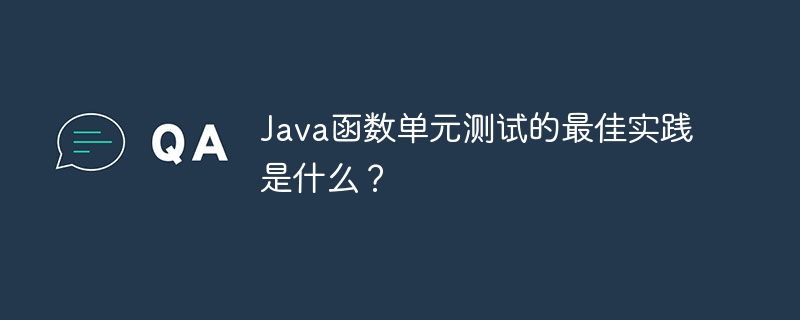What are the best practices for unit testing Java functions?
For Java function unit testing, best practices include: using a framework, such as JUnit, to maintain test consistency; isolating tests to ensure they run independently; Mock external dependencies to test functions independently; test all paths, including normal Negative examples; use boundary value analysis to test input boundaries; consider different usage scenarios and write corresponding test cases; automate testing and use continuous integration tools to ensure that tests run after each code change.

Best Practices for Java Function Unit Testing
Introduction
Unit Testing It is the foundation of any serious software development project. Unit tests are especially important for Java functions because they help you ensure that the function works as expected under various inputs.
This document will introduce the best practices for unit testing of Java functions. We'll cover everything from test setup to test case design.
Test setup
- Using a framework: There are many Java testing frameworks to choose from, such as JUnit, TestNG, and Mockito. Choose a framework and stick with it to keep your test code consistent.
- Isolated Testing: Each test case should be run independently of other test cases. This means you should not rely on global state or shared resources.
- Mock External Dependencies: If your function depends on a third-party library or external service, use mock objects in your tests. This will enable you to test your function independently of external resources.
Test case design
- Test all paths: Make sure your test cases cover all execution paths in the function. Includes positive and negative examples.
- Use boundary value analysis: Test the input boundary values of the function, such as minimum value, maximum value and null value.
- Consider different scenarios: Consider different scenarios where the function may be called and write test cases accordingly.
- Automated Testing: Use continuous integration tools to automate your tests to ensure they are run after every code change.
Practical example
The following is a sample unit test, testing a Java function named add():
import org.junit.jupiter.api.Test;
import static org.junit.jupiter.api.Assertions.assertEquals;
class AddFunctionTest {
@Test
void shouldAddTwoNumbers() {
// Arrange
int a = 5;
int b = 10;
// Act
int result = AddFunction.add(a, b);
// Assert
assertEquals(15, result);
}
}In this example, we set two test parameters and then call the function to be tested. Finally, we compare the result of the function to the expected value.
Conclusion
By following these best practices, you can ensure that your Java function unit tests are comprehensive and reliable. This will help you catch errors early during development and maintenance, and improve the overall quality of your code.
The above is the detailed content of What are the best practices for unit testing Java functions?. For more information, please follow other related articles on the PHP Chinese website!

Hot AI Tools

Undresser.AI Undress
AI-powered app for creating realistic nude photos

AI Clothes Remover
Online AI tool for removing clothes from photos.

Undress AI Tool
Undress images for free

Clothoff.io
AI clothes remover

AI Hentai Generator
Generate AI Hentai for free.

Hot Article

Hot Tools

Notepad++7.3.1
Easy-to-use and free code editor

SublimeText3 Chinese version
Chinese version, very easy to use

Zend Studio 13.0.1
Powerful PHP integrated development environment

Dreamweaver CS6
Visual web development tools

SublimeText3 Mac version
God-level code editing software (SublimeText3)

Hot Topics
 Square Root in Java
Aug 30, 2024 pm 04:26 PM
Square Root in Java
Aug 30, 2024 pm 04:26 PM
Guide to Square Root in Java. Here we discuss how Square Root works in Java with example and its code implementation respectively.
 Perfect Number in Java
Aug 30, 2024 pm 04:28 PM
Perfect Number in Java
Aug 30, 2024 pm 04:28 PM
Guide to Perfect Number in Java. Here we discuss the Definition, How to check Perfect number in Java?, examples with code implementation.
 Random Number Generator in Java
Aug 30, 2024 pm 04:27 PM
Random Number Generator in Java
Aug 30, 2024 pm 04:27 PM
Guide to Random Number Generator in Java. Here we discuss Functions in Java with examples and two different Generators with ther examples.
 Armstrong Number in Java
Aug 30, 2024 pm 04:26 PM
Armstrong Number in Java
Aug 30, 2024 pm 04:26 PM
Guide to the Armstrong Number in Java. Here we discuss an introduction to Armstrong's number in java along with some of the code.
 Weka in Java
Aug 30, 2024 pm 04:28 PM
Weka in Java
Aug 30, 2024 pm 04:28 PM
Guide to Weka in Java. Here we discuss the Introduction, how to use weka java, the type of platform, and advantages with examples.
 Smith Number in Java
Aug 30, 2024 pm 04:28 PM
Smith Number in Java
Aug 30, 2024 pm 04:28 PM
Guide to Smith Number in Java. Here we discuss the Definition, How to check smith number in Java? example with code implementation.
 Java Spring Interview Questions
Aug 30, 2024 pm 04:29 PM
Java Spring Interview Questions
Aug 30, 2024 pm 04:29 PM
In this article, we have kept the most asked Java Spring Interview Questions with their detailed answers. So that you can crack the interview.
 Break or return from Java 8 stream forEach?
Feb 07, 2025 pm 12:09 PM
Break or return from Java 8 stream forEach?
Feb 07, 2025 pm 12:09 PM
Java 8 introduces the Stream API, providing a powerful and expressive way to process data collections. However, a common question when using Stream is: How to break or return from a forEach operation? Traditional loops allow for early interruption or return, but Stream's forEach method does not directly support this method. This article will explain the reasons and explore alternative methods for implementing premature termination in Stream processing systems. Further reading: Java Stream API improvements Understand Stream forEach The forEach method is a terminal operation that performs one operation on each element in the Stream. Its design intention is






